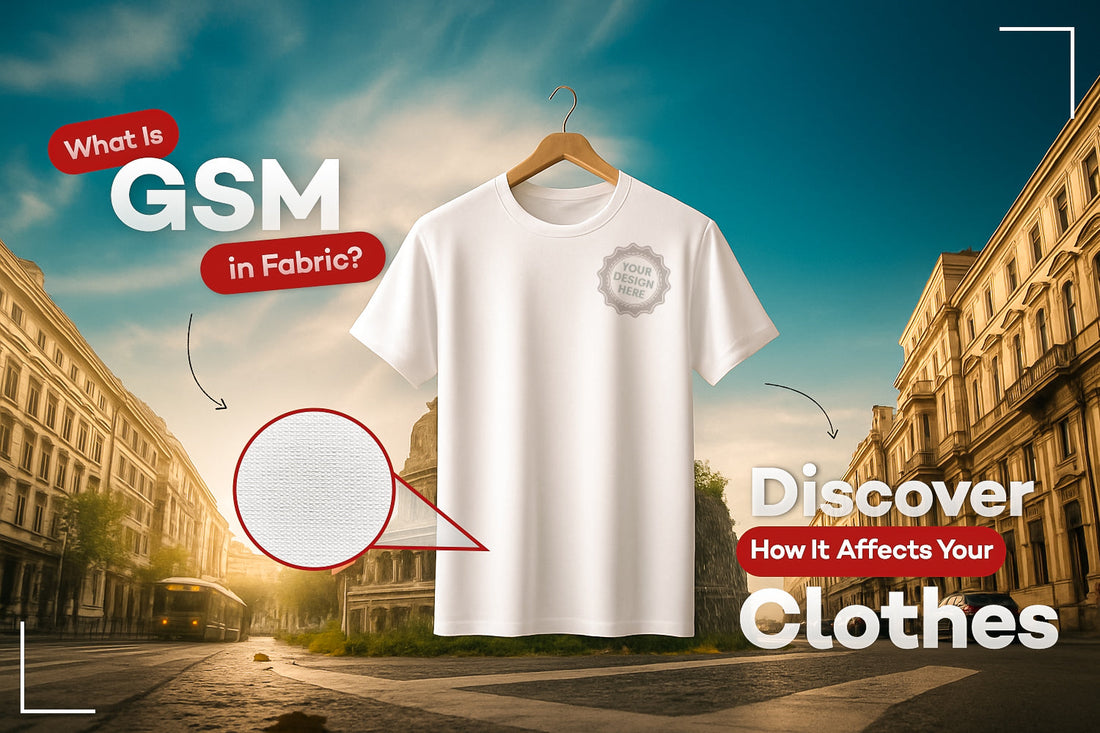
What is GSM in Fabric? Discover How It Affects Your Clothes
When shopping for clothing or considering custom apparel for your team or event, the term GSM often comes up, but what does it actually mean? Understanding GSM (Grams per Square Meter) is essential to making informed decisions about the clothes you wear, whether it's for casual daily wear, performance gear, or promotional items for your brand. In this blog, we’ll explore what GSM in fabric is, how it impacts the quality and feel of your clothes, and why it's crucial for businesses and consumers to understand when choosing custom apparel.
What is GSM in Fabric?
GSM stands for Grams per Square Meter, which is a unit of measurement used to determine the weight of fabric. The GSM measurement tells you how much a square meter of fabric weighs in grams. This weight directly affects the fabric’s thickness, durability, and feel. Higher GSM indicates thicker and more durable fabric, while lower GSM generally means a lighter, softer fabric.
When you are purchasing clothing, especially custom apparel, understanding the GSM helps you determine the quality, comfort, and suitability of the fabric for the intended use. Whether you're ordering custom t-shirts for a promotional event or polo shirts for your employees, knowing how to choose the right GSM ensures that the fabric will perform well and maintain its look over time.
Why Does GSM Matter in Clothing?
The GSM of fabric significantly influences several factors that directly impact how the fabric behaves. Here's why GSM matters:
1. Fabric Weight and Thickness
The weight and thickness of fabric are essential in determining how it feels and performs. For instance, a heavier GSM fabric (e.g., 250 GSM) will be thicker, providing warmth and durability, while a lighter fabric (e.g., 120 GSM) will be thin, more breathable, and ideal for hot weather.
-
Thicker Fabrics: Ideal for cooler temperatures or when durability is important (e.g., sweatshirts, jackets, or heavy-duty work shirts).
-
Lighter Fabrics: Perfect for warm climates or high-performance activewear where breathability and comfort are paramount (e.g., summer t-shirts or activewear).
2. Durability and Longevity
Heavier fabrics, indicated by a higher GSM, generally last longer. For example, men’s oversized tee (around 200-220 GSM) tend to hold their shape better after multiple washes and maintain a premium feel. Thinner fabrics may wear out faster and lose their shape more easily.
When choosing custom apparel for your business or event, you want a fabric that stands up to frequent use and washing. Opting for the right GSM ensures that the custom shirts, polos, or activewear you choose will look great for longer.
3. Feel and Comfort
The GSM plays a critical role in the comfort of the garment. Higher GSM fabrics, such as thick cotton, tend to feel more substantial and provide warmth, making them suitable for colder weather. Lighter GSM fabrics, like those used for lightweight t-shirts or performance gear, are soft and breathable, making them ideal for warm conditions or for use during physical activity.
For businesses ordering for team uniforms or promotional events, it's important to find a balance between comfort and style. A too-thin fabric might feel uncomfortable after prolonged wear, while a too-heavy fabric could be too warm for active use.
4. Customization and Printing
When it comes to custom apparel printing, the GSM of fabric also affects how well the printing process works. Heavier fabrics are often more robust and provide a better canvas for vibrant and detailed designs. However, lighter fabrics may require a more careful approach to printing to ensure the quality remains intact without compromising the integrity of the fabric.
Choosing the right GSM helps ensure that your logo, design, or slogan will be printed clearly, and the garment will maintain its quality after multiple washes.
How to Choose the Right GSM for Your Custom Apparel
Choosing the right GSM depends on the type of apparel you’re customizing and the intended use. Here's a breakdown of the ideal GSM range for different types of clothing:
1. Custom T-Shirts
For custom t-shirts, the GSM usually ranges between 140-200 GSM.
-
Lightweight (140-160 GSM): This GSM is suitable for hot weather or for creating lightweight summer shirts. These shirts are breathable and comfortable, ideal for casual wear or promotional events.
-
Medium Weight (160-180 GSM): This GSM provides a balance of durability and comfort. It’s the most commonly used for custom t-shirts, ensuring they are neither too thick nor too thin, making them great for everyday wear or events.
-
Heavyweight (180-200 GSM): A heavier fabric, typically used for premium t-shirts or those meant for cooler weather. These shirts are more durable and have a more substantial feel.
For custom t-shirts, 200 GSM is often ideal as it provides a good balance between durability and breathability.
2. Custom Polo Shirts
Custom polo shirts typically have a higher GSM, ranging from 180-250 GSM.
-
180-200 GSM: Suitable for businesses looking for a lightweight, comfortable polo shirt for casual office wear or outdoor events. These polos are breathable but still have a structured look.
-
220-250 GSM: This GSM range is used for thicker, more premium polos, often used for corporate uniforms, where durability and a more professional look are desired.
3. Activewear and Sports Apparel
For activewear or sports-related custom apparel, a lighter GSM is usually preferred to allow for flexibility and comfort.
-
120-140 GSM: Great for running shirts, workout wear, or jerseys, as these fabrics are designed to wick away sweat and keep the wearer cool.
-
160-180 GSM: Often used for more durable workout gear, these fabrics provide a mix of breathability and performance for athletes.
4. Sweatshirts and Jackets
For colder months or outdoor events, thicker fabrics in the 250-350 GSM range are perfect for custom sweatshirts and jackets. These heavier fabrics provide insulation and warmth, making them ideal for layering or for winter events.
How GSM Affects the Printing Process
The GSM can impact how your custom designs are printed. Heavier fabrics often provide a more suitable surface for printing because they are more stable and durable. For example, t shirt with custom logo must have a higher GSM to provide a solid base for screen printing and other methods, ensuring that the logo or design remains vibrant and intact.
-
Thicker Fabrics: Easier to print on, and the designs tend to be more long-lasting.
-
Thinner Fabrics: May require more delicate handling during the printing process to avoid distortion or fading.
For custom apparel, it's important to work with a printer who understands how fabric weight can affect print quality and durability.
Conclusion
Understanding GSM is essential when choosing custom apparel for your business, event, or team. The weight of the fabric impacts comfort, durability, and the quality of the print. By selecting the right GSM for your custom t-shirts, polo shirts, or activewear, you can ensure that your apparel not only looks great but also lasts longer and feels comfortable to wear.
Whether you are designing company logo shirts or custom polos for your team, knowing how to choose the appropriate GSM is key to creating high-quality clothing that will make a lasting impression. Always consider the type of activity, season, and branding needs when selecting the fabric GSM, as it plays a significant role in the overall success of your custom apparel.
